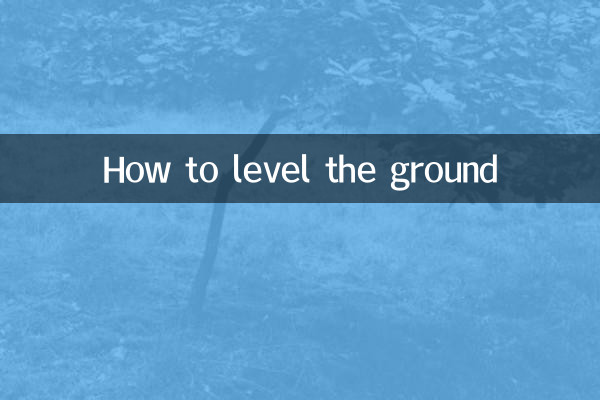How to level the ground
Leveling the ground is a crucial step during a home renovation or construction project. Whether it is laying floors, ceramic tiles or other decorative materials, the flatness of the ground directly affects the final effect and user experience. This article will combine the hot topics and hot content on the Internet in the past 10 days to give you a detailed introduction to the methods and techniques of leveling the ground.
1. The importance of leveling the ground

Leveling the ground is not only for aesthetics, but also to ensure the smooth progress of subsequent construction. Uneven floors can cause problems such as floor warping and tile hollowing, and can even affect the placement and use of furniture. Therefore, it is important to master the correct leveling method.
2. Common methods for leveling the ground
According to recent popular discussions on the Internet, the following are several common leveling methods and their applicable scenarios:
| method | Applicable scenarios | advantage | shortcoming |
|---|---|---|---|
| Cement mortar leveling | Large area ground leveling | Low cost and simple construction | Long drying time and easy to crack |
| self-leveling cement | Small area or high precision leveling | High flatness and fast drying | higher cost |
| Plaster leveling | local leveling | Fast construction and environmentally friendly | Not suitable for wet environments |
| Keel leveling | wooden floor laying | Flexible adjustment and moisture-proof | Occupied floor height |
3. Specific steps for leveling the ground
Taking cement mortar leveling as an example, the following are the detailed construction steps:
1.clear the ground: Remove dust, oil and other debris on the ground to ensure the base is clean.
2.Check flatness: Use a level or ruler to check the height difference on the ground and mark the area that needs to be leveled.
3.Mix mortar: Mix cement and sand according to the proportion, add appropriate amount of water and mix evenly.
4.laying mortar: Spread the mixed mortar evenly on the ground and scrape it evenly with a scraper.
5.maintenance: After leveling is completed, keep the ground moist to avoid cracking. The curing time is generally 7 days.
4. Precautions for leveling the ground
1.ambient temperature: The construction environment temperature should be above 5℃ to avoid low temperature affecting the solidification of mortar.
2.Basic treatment: If the base layer is too smooth, it needs to be roughened first to enhance the adhesion of the mortar.
3.Material selection: Choose appropriate leveling materials according to ground conditions to avoid leveling failure due to improper materials.
4.Construction thickness: The thickness of cement mortar leveling is generally not less than 20mm. If it is too thin, it will easily crack.
5. Analysis of hot topics across the entire network
According to the statistics of the past 10 days, the following are hot topics related to leveling the ground:
| Ranking | hot topics | amount of discussion |
|---|---|---|
| 1 | Advantages and disadvantages of self-leveling cement | 12,345 |
| 2 | What to do if cement mortar is leveled and cracked | 9,876 |
| 3 | Leveling tips before floor laying | 8,765 |
| 4 | The best method for local leveling | 7,654 |
6. Summary
Leveling the floor is a link that cannot be ignored in decoration. Choosing the right methods and materials can get twice the result with half the effort. Whether it is cement mortar leveling or self-leveling cement, it needs to be used flexibly according to the actual situation. I hope that through the introduction of this article, you can master the key skills of leveling the ground and lay a solid foundation for subsequent construction.

check the details

check the details